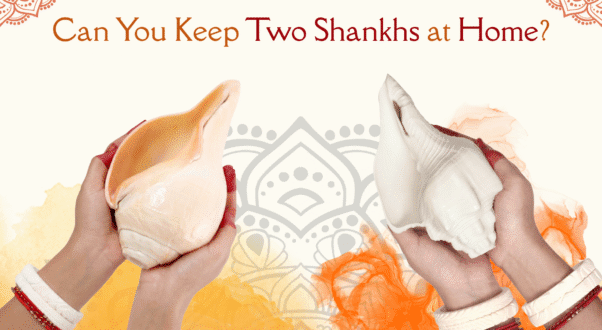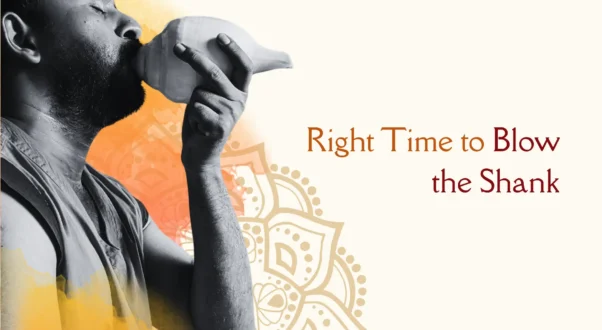
Shankh as a Weapon for Health: Strengthening Lungs & Core Naturally
When it’s about the realm of traditional Indian ritual of puja’s and aarti’s, the Shankh holds its revered place. It is not an item or sign of spirituality, but holds a power for health and well-being. Maybe you don’t feel it yet, but you’ll surely believe it after reading.
In fact, there is a Correct Method of Blowing Shankh—that’s all linked within practice; it engages the lungs, breath, diaphragm and core muscles. Shankh blowing contributes significantly to energy and has a substantial impact on both physical and mental fitness.
It’s an ancient instrument, yet a tool to rediscover health every day. Therefore, it is known for its endless benefits in respiratory wellness, mindfulness, and stress relief. Let’s dive deep into the article that explores how Shankh blowing improves wellness, what the correct technique is, and where to get Shankh Online if you want to begin this mindful practice.
The Science Behind Blowing the Shankh
Blowing a conch shell needs the right technique and practice, which isn’t as easy as it may seem. To understand the correct method of blowing the Shankh, it’s essential to know that it involves deep inhalation with forceful exhalation through a narrow opening. This process naturally lets the whole respiratory system have natural exercise, which includes perfect coordination of;
- Lungs – to hold and expel air forcefully.
- Diaphragm – the primary muscle of respiration that contracts during inhalation.
- Abdominal & core muscles – to maintain pressure and posture during the blow.
Thus, it ends with a creation of resonant sound and strong vibration. The vibrations or cosmic sound—Om give deep relaxation. Meanwhile, travel through the chest cavity, sinuses and skull, which improves circulation and relieves congestion. The regular practice of blowing Shankh builds lung capacity, strengthens respiratory muscles and improves core stability.
Correct Method of Blowing the Shankh
If you are willing to learn the right way to blow Shankh, then ensure effectiveness and safety simultaneously. For beginners, Shankh Instrument blowing may be challenging, but with the right technique and consistent practice, it can improve. Follow the steps below;
Posture
- Sit or stand upright with a straight spine to allow full lung expansion.
- Relax your shoulders and unclench your jaw.
Hold the Shankh Correctly
- Grip the conch shell with both hands, keeping the blowing end at mouth level.
- Ensure it is clean and dry.
Breath Preparation
- Inhale deeply through the nose, expanding the diaphragm and abdomen.
- Hold your breath for 2–3 seconds to build pressure.
Blowing Technique
- Place the lips firmly on the mouthpiece, as if blowing into a trumpet.
- Exhale forcefully in a steady stream of air to produce the resonant sound.
- Avoid straining or overexerting—start with short blows of 3–5 seconds.
Repetition & Duration
- Do 3–5 rounds initially, gradually increasing as lung capacity improves.
- Pause between blows to relax and breathe normally.
Important:
It’s just about therapy and mindfulness; practising it daily will make you a pro. However, it is best to do this on an empty stomach and avoid blowing the conch shell if you aren’t well or feeling dizzy. Beginners should go slowly and consult a wellness expert if they have chronic respiratory conditions.
Shankh Therapy and Mindfulness Benefits
If you are wondering how to blow the Shankh, it is a great way to start. It’s a mindful sound therapy and breathwork that benefits beyond physical wellness.
Mindfulness and Focus
The deep breathing required brings attention inward, calming the mind and promoting presence. It helps regulate the nervous system and can reduce anxiety.
Stress Reduction
The resonant sound acts like a sonic massage, stimulating the parasympathetic nervous system, which induces relaxation.
Cleansing Energy
In traditional Indian belief, the sound of the Shankh is said to dispel negative energy, uplifting the surroundings and purifying mental states.
Improved Lung Function
Over time, the practice trains your lungs to inhale more air and exhale efficiently, which improves oxygen delivery to tissues.
Stronger Core
The exhalation pressure naturally engages the abdominal wall, strengthening the core muscles and improving posture.
In fact, today many wellness centres, yoga retreats and health practices studios offer Therapy Mindfulness with a Shankh blowing session. It’s not included as part of the holistic therapies for respiratory wellness, focus and emotional release.
Shankh as a Musical Instrument
No matter that Shankh is rooted in the Indian tradition, it is also used as a musical wind instrument in many other cultures.Shankh Instrument is even blown in Hawaii and Polynesia as a mark of ceremonies and signal events. It’s even reinforced to produce deep cosmic sound resonating at varying pitches.
Where to Find a Shankh Online
If you are in the mood to buy Shankh online, don’t make a hasty decision from any random website. However, it’s as simple as many Indian handicraft and wellness platforms offer authentic, natural conch shells. It’s within features like—
- Natural origin – real conch shell (not resin or plastic replicas)
- Proper size – medium size is ideal for beginners
- Clean finish – check for smooth, intact blowing edge
- Hollow interior – ensures resonance and good airflow
Websites such as Indian handicraft stores, wellness product platforms, and large marketplaces often list them under “blowing Shankh” or “conch shell instrument.” It’s worth investing in a quality Shankh to get the right tone and ease of blowing.
How to Improve Lung Health Alongside Shankh Practice
If you are following the correct method of blowing Shankh, then definitely it’s a powerful start. From combining it with modern lifestyle and wellness, it shares a lot of benefits as follows;
- Daily Breathing Exercises
- Physical Activity
- Good Posture
- Clean Air and Hydration
- Nutritious Diet
The Final Verdict
Don’t stop wondering if you aren’t sure about the scared Shankh. How profound, not only does it strengthen and promote lung health, but also deeply strengthens and promotes lung health. Blowing the conch shell will help improve your lungs, tone your core, calm your mind and energise your spirit. It’s modern fitness that gives deep practice—evolves wellness. The Shankh instrument may be small, but it has mighty benefits.
FAQs
Q1. How often should I blow the Shankh for health benefits?
It’s best to start with 3–5 rounds once a day, preferably in the morning on an empty stomach. As you build stamina, you can increase to 10 rounds daily. Consistency matters more than duration.
Q2. Can children or older adults practice Shankh blowing?
Yes, but they should start slowly and gently. Children can benefit from improved lung capacity, while older adults may experience better breathing and relaxation. Anyone with respiratory or heart conditions should seek medical advice before starting.
Q3. What if no sound comes out when I blow the Shankh?
This is common for beginners. It takes practice to seal the lips correctly and build enough air pressure. Focus on posture, deep inhalation, and a firm yet relaxed exhalation. Within a few days of practice, the sound usually emerges.
Explore insights from Kalari Warriors, blending ancient Kalaripayattu traditions with spiritual craftsmanship to enrich your life and rituals.




